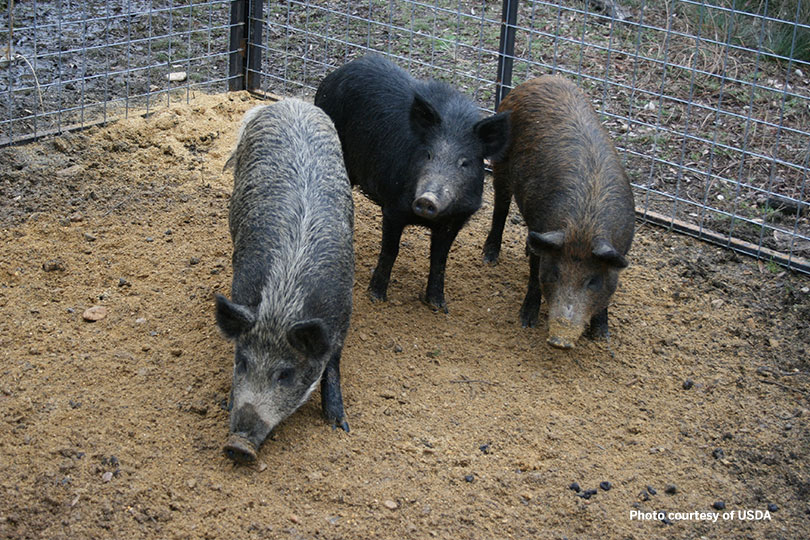By Julie Tomascik
Editor
A program created through the 2018 Farm Bill is helping landowners in select counties control feral hogs.
The Feral Swine Eradication and Control Pilot Program was established to respond to the threats that feral swine pose to agriculture, native ecosystems and human and animal health.
It’s a partnership between state and federal agencies and landowners.
The program is administered by local soil and water conservation districts, Texas State Soil and Water Conservation Board (TSSWCB), Texas Wildlife Damage Management Association, Texas A&M Natural Resources Institute and the U.S. Department of Agriculture’s Natural Resources Conservation Service and Animal and Plant Health Inspection Service.
Texas Farm Bureau (TFB) joined the effort to help maximize its effectiveness.
“TFB members have made feral hog control efforts an organizational priority in recent years, so the program fits our goals,” Tracy Tomascik, TFB associate director of Commodity and Regulatory Activities, said. “Our hope is that helping these counties achieve success will pave a road for program expansion in coming years and show that a coordinated effort can reduce the impact feral hogs have on agriculture and our rural communities.”
USDA is focusing eradication and control efforts where feral swine pose the highest threat.
First round success
Ten counties are in the first round of the project.
There are three counties in the Panhandle—Hartley, Oldham and Potter. There are four counties along the Red River—Clay, Hardeman, Wichita and Wilbarger. In the Upper Leon River area of Central Texas, three counties—Comanche, Eastland and Erath—are included.
“Those counties have been active for over a year now,” Liza Parker, policy analyst and legislative liaison for TSSWCB, said. “Through the trap loan efforts, 100 landowners have been assisted, and those landowners have trapped over 3,800 hogs.”
Resources will be available to landowners in these counties through September 2023.
Second round details
The program is expanding into six additional counties.
Milam and Williamson counties were added in Central Texas. Along the coast, Bee, Nueces and San Patricio counties were added, and the project was expanded in the Panhandle to include Dallam County.
“Technicians are available through the trap loan program to assist the landowner in getting signed up. They will take the trap out to the landowner’s place and set it up,” Parker said. “The technicians show them how to use the app and how to trigger the gate. They provide resources on how to best bait them. They’re also available any time the landowner might have questions, concerns or just need technical assistance with the trap.”
There are currently 30 smart traps available for these project areas, but Parker expects more will be available in the coming months.
As of late August, 23 landowners have been assisted and trapped over 130 hogs.
Sign up
Interested landowners in any of the program counties can find out more information and get connected to the appropriate resources at TSSWCB.texas.gov/feral-swine-texas.
There will be outreach education and demonstration events scheduled for the project areas. Information about those events will also be available on the TSSWCB website.
“The success of this program is dependent on the participation of landowners. We provide the resources, but we are dependent on landowners signing up and utilizing them for the success,” she said. “The landowners’ time is extremely important to these efforts. They’re the ones who are going to be monitoring the traps and also triggering the traps and taking care of the hogs that they capture.”
About feral hogs
There are an estimated 2.6 million feral hogs in Texas.
They can degrade water quality and introduce E. coli, making the water unsafe to drink. Feral hogs also pose a threat to livestock and wildlife, preying on small animals.
Crop damages and control costs associated with feral hogs totals around $1.5 billion annually.
The destructive species is now considered a national threat due to the liability they create for Texas waterways and ecosystems.

